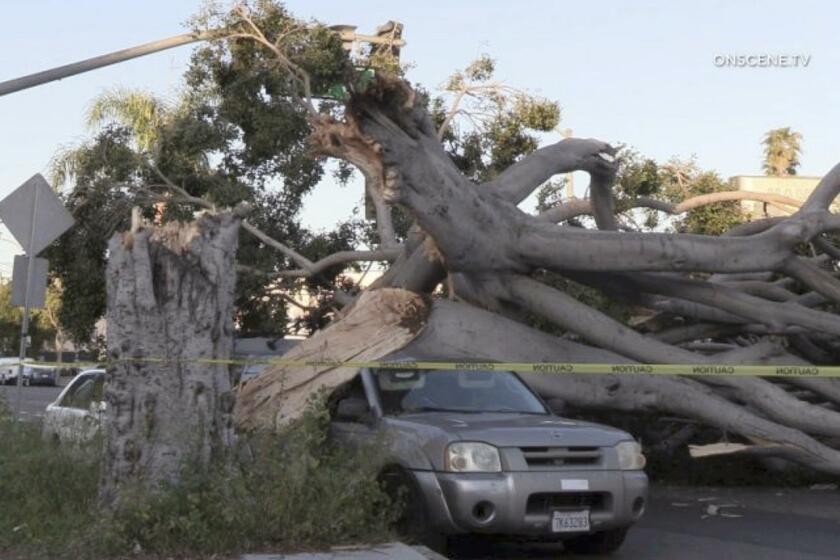Debate Rages Over Plan to Redevelop S. Pasadena Areas
One man’s blight is another man’s quaint little neighborhood.
So it seems after several months of rancorous public debate on a city plan to declare a large swath of the city’s downtown as a redevelopment area.
Orange County consultant Marshall Krupp, who has been hired by the city’s Community Redevelopment Agency to prepare a redevelopment plan, contends that parts of the city’s unassuming commercial center are blighted.
At a meeting Monday on the proposed Gateway Redevelopment Project, he showed slides of South Pasadena neighborhoods with cracked sidewalks, boarded up buildings and crudely fashioned signs. Blight? “It’s very evident,” he contended. “Most of the buildings are pre-1949 buildings which don’t meet state earthquake standards. There’s age, deterioration, dilapidation.”
Testy Responses
Residents of this conservative city of 24,000 responded testily. “It’s like somebody who comes to your house and starts picking it apart,” sniffed Ellen Daigle, who owns a silk-screening shop on Mission Street, in the heart of the proposed redevelopment area.
It may be frayed around the edges here and there, but the city is far from blighted, defenders insisted. South Pasadena, with its fiercely protected small-town character, represents “the end of the Norman Rockwell era,” Daigle contended.
“It’s like having a pimple and cutting off your arm,” Daigle said.
At issue is whether the city should place about 74 acres of the city under the authority of the 5-person Community Redevelopment Agency. Under state law, additional property taxes that are brought in with redevelopment in areas designated as blighted would go to the CRA for public improvements or for subsidizing development. Redevelopment officials call such funds tax increment money.
The agency, whose members also compose the City Council, is scheduled to vote on the proposal in December. In the interim, it will hold a series of public workshops to air the plan and listen to residents’ suggestions, said Mayor James Woollacott, who emphasized that he and his colleagues have yet to decide on the issue.
Prevents Cloak Room Actions
“There has to be community involvement in the process,” he said. “It prevents someone from just going into the cloak room and cranking out something and shoving it down people’s throats.”
This is no mega-development project, Krupp insists. The idea of Gateway, he said, is to use tax increment money strictly for cosmetic improvements such as repaving streets and gutters or for providing low-interest loans for “earthquaking” (bringing the property up to state earthquake standards).
“It’s intended to be a financing assistance program to help property owners and existing businesses in the project area,” Krupp said. “Anyone who tells you anything different doesn’t understand the project.”
The proposed Gateway project includes both sides of Fair Oaks Avenue, one of the city’s prime commercial strips, from the northern city line to Mission Street, and an adjoining patch that includes Mission between Brent and Meridian avenues, and parts of Hope and El Centro streets. Most of this part of the project is commercial, though there are some homes on Brent and Hope that will be affected.
Dissident Merchants
The area also includes three smaller, non-contiguous areas, which are mostly commercial. These center on Fair Oaks and Huntington Drive, Fletcher Avenue and Huntington and Fair Oaks and Monterey Road.
Dissident merchants, many of whom have come together to form Citizens Against Eminent Domain, have greeted assurances from Krupp and CRA officials about the modesty of their intentions with rank suspicion.
First, they worry about the CRA’s authority to seize private property under eminent domain.
“They’re saying they don’t intend to do anything except collect tax increments that could possibly be generated downstream,” said former City Councilman Robert Wagner, who has continued to play a gadfly role in city politics since declining to run for a second term last spring. “But it casts a gray shadow. The homeowners and property owners would always be under the possible danger of eminent domain. The big question is, can you trust government?”
Most critics answer that question with a resounding “no.”
Word of the Gateway project came about the same time as a developer’s proposal to tear down eight stores on another block of Fair Oaks to build a 150-suite hotel. “I got a letter from the city asking if I’d like to relocate,” said Juli Jorgensen, owner of Sonnie’s, a women’s clothing store on the site of the proposed hotel. “They said they were considering redeveloping the block. At that point, I started asking a lot of questions.”
Insist on No Linkage
Though Krupp and CRA officials insist there is no linkage between the hotel project and Gateway, Jorgensen says they are connected in the minds of South Pasadenans.
“What we see are people sitting on the CRA and proposing some very big changes to a 4-square-mile town,” she said.
The merchants group is gearing up for a referendum campaign against Gateway. The group has hired a consultant of its own: slow-growth activist Sherry Passmore.
“The golden carrot they dangle is those low-interest loans to earthquake your buildings,” Passmore said. “But there are other ways to make the required improvements without adopting an expensive form of government.”
Long-Term Debt
Passmore contends that redevelopment would commit the financially beleaguered city to new long-term debt. The city faced budget deficits and service cutbacks last year, before voters approved a 4% utility tax for two years. “In city after city (that adopted a redevelopment project),” Passmore said, “general fund money was transferred to the Redevelopment Agency to help them pay their debts.”
But Woollacott insisted that there could be palpable benefits for South Pasadenans in the plan. “We can do a lot of things with the tax increment dollar,” he said. “I’m not talking about tearing things down but about revitalizing blocks. What if we could lend the money out to merchants at, say, 2% interest, so the merchants could modernize their buildings? As an elected body, we’d be remiss if we didn’t consider the idea.”
More to Read
Start your day right
Sign up for Essential California for news, features and recommendations from the L.A. Times and beyond in your inbox six days a week.
You may occasionally receive promotional content from the Los Angeles Times.





